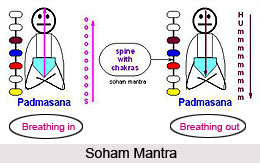 Vedas affirms the truth that "Speech is the essence of humanity" as ideas remain unutilized if not spoken. Mantras, which are indeed the energy-based, sounds therefore aids in taming the mind whilst regulating the nervous system.
Vedas affirms the truth that "Speech is the essence of humanity" as ideas remain unutilized if not spoken. Mantras, which are indeed the energy-based, sounds therefore aids in taming the mind whilst regulating the nervous system.
The soham mantra is a natural mantra in meditation, which is derived, as sooo is the sound of inhalation and hummm is the sound of exhalation. This has been called the universal mantra because its vibration plays an important part in breathing.
Soham mantra is practiced at a steady, slow speed with longer exhalation and thus regulates the nervous system, relaxes the body, and quiets the mind. It is the finest, easiest and most direct ways to train the breath. The Soham mantra is extremely useful when practiced along with diaphragmatic breathing.
The deeper ways to use the soham mantra is through spinal breath by coordinating body, breath and mind. Inhaling allows the mind to be aware of the vibration soooo as to attention moves upward along the subtle cord of the spine, through the charkas towards the crown of the head while exhaling allows the mind to be aware of the vibration Hmmm as the attention moves downwards along the subtle spine towards the perineum at the base of the spine, at the flat place between the genital area and the anus. Meditation with soham at the nostrils is a very effective practice that stabilizes and purifies the mind, and also helps in increasing concentration, which is most important for meditation. The breath, though actually a result or manifestation of the kundalini, is a means of awakening the fire. By blowing the vibration so-hum, so-hum, the Soham mantra is gently blowing on a glowing ember. Gradually and surely, the glow turns into a fire.




















